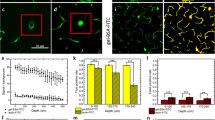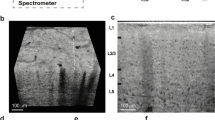Abstract
It is important to digitally reconstruct the 3D morphology of neurons and brain vasculatures. A number of previous methods have been proposed to automate the reconstruction process. However, in many cases, noise and low signal contrast with respect to the image background still hamper our ability to use automation methods directly. Here, we propose an adaptive image enhancement method specifically designed to improve the signal-to-noise ratio of several types of individual neurons and brain vasculature images. Our method is based on detecting the salient features of fibrous structures, e.g. the axon and dendrites combined with adaptive estimation of the optimal context windows where such saliency would be detected. We tested this method for a range of brain image datasets and imaging modalities, including bright-field, confocal and multiphoton fluorescent images of neurons, and magnetic resonance angiograms. Applying our adaptive enhancement to these datasets led to improved accuracy and speed in automated tracing of complicated morphology of neurons and vasculatures.














Similar content being viewed by others
References
Agaian, S. S., Silver, B., & Panetta, K. A. (2007). Transform coefficient histogram-based image enhancement algorithms using contrast entropy. Image Processing, IEEE Transactions on, 16(3), 741–758.
Al-Kofahi, K. A., Lasek, S., Szarowski, D. H., Pace, C. J., Nagy, G., Turner, J. N., & Roysam, B. (2002). Rapid automated three-dimensional tracing of neurons from confocal image stacks. Information Technology in Biomedicine, IEEE Transactions on, 6(2), 171–187.
Andersen, A., & Kak, A. (1984). Simultaneous algebraic reconstruction technique (SART): a superior implementation of the ART algorithm. Ultrasonic Imaging, 6(1), 81–94.
Choromanska, A., Chang, S.-F., & Yuste, R. (2012). Automatic reconstruction of neural morphologies with multi-scale tracking. Frontiers in neural circuits, 6.
Cohen, A., Roysam, B., & Turner, J. (1994). Automated tracing and volume measurements of neurons from 3‐D confocal fluorescence microscopy data. Journal of Microscopy, 173(2), 103–114.
DeFelipe J, López-Cruz PL, Benavides-Piccione R, Bielza C, Larrañaga P, Anderson S, Burkhalter A, Cauli B, Fairén A, Feldmeyer D (2013) New insights into the classification and nomenclature of cortical GABAergic interneurons. Nature Reviews Neuroscience
Donohue, D. E., & Ascoli, G. A. (2011). Automated reconstruction of neuronal morphology: an overview. Brain Research Reviews, 67(1), 94–102.
Gerig, G., Kubler, O., Kikinis, R., & Jolesz, F. A. (1992). Nonlinear anisotropic filtering of MRI data. Medical Imaging, IEEE Transactions on, 11(2), 221–232.
Gillette, T. A., Brown, K. M., Svoboda, K., Liu, Y., & Ascoli, G. A. (2011). DIADEMchallenge. Org: a compendium of resources fostering the continuous development of automated neuronal reconstruction. Neuroinformatics, 9(2), 303–304.
Gonzalez-Bellido, P. T., Peng, H., Yang, J., Georgopoulos, A. P., & Olberg, R. M. (2013). Eight pairs of descending visual neurons in the dragonfly give wing motor centers accurate population vector of prey direction. Proceedings of the National Academy of Sciences, 110(2), 696–701.
Greenspan, H., Anderson, C. H., & Akber, S. (2000). Image enhancement by nonlinear extrapolation in frequency space. Image Processing, IEEE Transactions on, 9(6), 1035–1048.
Hayman, M., Smith, K., Cameron, N., & Przyborski, S. (2004). Enhanced neurite outgrowth by human neurons grown on solid three-dimensional scaffolds. Biochemical and Biophysical Research Communications, 314(2), 483–488.
Helmstaedter, M., Briggman, K. L., Turaga, S. C., Jain, V., Seung, H. S., & Denk, W. (2013). Connectomic reconstruction of the inner plexiform layer in the mouse retina. Nature, 500(7461), 168–174.
Kawaguchi, Y., Karube, F., & Kubota, Y. (2006). Dendritic branch typing and spine expression patterns in cortical nonpyramidal cells. Cerebral Cortex, 16(5), 696–711.
Kim, J. S., Greene, M. J., Zlateski, A., Lee, K., Richardson, M., Turaga, S. C., Purcaro, M., Balkam, M., Robinson, A., & Behabadi, B. F. (2014). Space-time wiring specificity supports direction selectivity in the retina. Nature, 509(7500), 331–336.
Krahe, T. E., El-Danaf, R. N., Dilger, E. K., Henderson, S. C., & Guido, W. (2011). Morphologically distinct classes of relay cells exhibit regional preferences in the dorsal lateral geniculate nucleus of the mouse. The Journal of Neuroscience, 31(48), 17437–17448.
Li, Q., Sone, S., & Doi, K. (2003). Selective enhancement filters for nodules, vessels, and airway walls in two-and three-dimensional CT scans. Medical Physics, 30, 2040.
Lu, J., Fiala, J. C., & Lichtman, J. W. (2009). Semi-automated reconstruction of neural processes from large numbers of fluorescence images. PloS One, 4(5), e5655.
Oberlaender, M., Bruno, R. M., Sakmann, B., & Broser, P. J. (2007). Transmitted light brightfield mosaic microscopy for three-dimensional tracing of single neuron morphology. Journal of Biomedical Optics, 12(6), 064029.
Peng, H., Ruan, Z., Atasoy, D., & Sternson, S. (2010a). Automatic reconstruction of 3D neuron structures using a graph-augmented deformable model. Bioinformatics, 26(12), i38–i46.
Peng, H., Ruan, Z., Long, F., Simpson, J. H., & Myers, E. W. (2010b). V3D enables real-time 3D visualization and quantitative analysis of large-scale biological image data sets. Nature Biotechnology, 28(4), 348–353.
Peng, H., Long, F., & Myers, G. (2011). Automatic 3D neuron tracing using all-path pruning. Bioinformatics, 27(13), i239–i247.
Peng, H., Roysam, B., & Ascoli, G. A. (2013). Automated image computing reshapes computational neuroscience. BMC Bioinformatics, 14(1), 293.
Peng, H., Bria, A., Zhou, Z., Iannello, G., & Long, F. (2014). Extensible visualization and analysis for multidimensional images using Vaa3D. Nature Protocols, 9(1), 193–208.
Rutovitz D (1968) Data structures for operations on digital images. Pictorial pattern recognition:105–133
Sato Y, Nakajima S, Atsumi H, Koller T, Gerig G, Yoshida S, Kikinis R 3D multi-scale line filter for segmentation and visualization of curvilinear structures in medical images. In: CVRMed-MRCAS’97, 1997. Springer, pp 213–222
The Brain Vasculature (BraVa) database (2014). The Krasnow Institute for Advanced Study, George Mason University. http://cng.gmu.edu/brava.
Weickert J (1996) Theoretical foundations of anisotropic diffusion in image processing. In: Theoretical foundations of computer vision. Springer, pp 221–236
Wright SN, Kochunov P, Mut F, Bergamino M, Brown KM, Mazziotta JC, Toga AW, Cebral JR, Ascoli GA (2013) Digital Reconstruction and Morphometric Analysis of Human Brain Arterial Vasculature from Magnetic Resonance Angiography. NeuroImage
Xiao, H., & Peng, H. (2013). APP2: automatic tracing of 3D neuron morphology based on hierarchical pruning of a gray-weighted image distance-tree. Bioinformatics, 29(11), 1448–1454.
Yu, Y., & Acton, S. T. (2002). Speckle reducing anisotropic diffusion. Image Processing, IEEE Transactions on, 11(11), 1260–1270.
Zhao, T., Xie, J., Amat, F., Clack, N., Ahammad, P., Peng, H., Long, F., & Myers, E. (2011). Automated reconstruction of neuronal morphology based on local geometrical and global structural models. Neuroinformatics, 9(2–3), 247–261.
Acknowledgments
We thank Rafael Yuste for providing samples of mouse pyramidal neurons, Paloma Gonzalez-Bellido for providing the dragonfly confocal images, Peter Kochunov for providing the MRA brain images, and Brian Long for comments. This work is supported by Allen Institute for Brain Science.
Author information
Authors and Affiliations
Corresponding author
Additional information
Availability: This method has been implemented as an Open Source plugin for Vaa3D (http://vaa3d.org).
Rights and permissions
About this article
Cite this article
Zhou, Z., Sorensen, S., Zeng, H. et al. Adaptive Image Enhancement for Tracing 3D Morphologies of Neurons and Brain Vasculatures. Neuroinform 13, 153–166 (2015). https://doi.org/10.1007/s12021-014-9249-y
Published:
Issue Date:
DOI: https://doi.org/10.1007/s12021-014-9249-y




